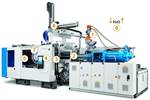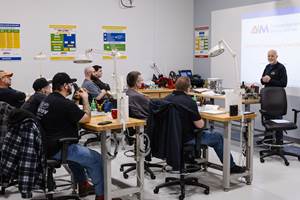Getting You to Think in Plastic First
The next step is to take the lessons learned from this series over the past year and figure out how to impart them to the future moldmaking/molding workforce.
The primary focus of this series has been turning the complexities of manufacturing into a planned return on investment. This requires vision, communication and a sustainability plan that can only come from harnessing all the technology, experience, skill and personalities of the supply chain into molding plastic parts that meet quality, on-time delivery and quoted process requirements. We suggested you take a “think in plastic first, then steel” engineering approach to help transform your business. We presented expertise from people and companies that shared their experiences to help you better understand plastic injection molding so you could add more value to your mold manufacturing operations. As the series continues next month, we will build off this foundation and dive deeper into the future of moldmaking and molding as it pertains to skilled labor. We will be asking ourselves, “Where will they come from?”
Success Comes from the Right Team
A successful future for our industry requires people with experience of the past using technologies of the present and passing that knowledge onto the next generation. “They” are the great minds who possess the ability to learn from anyone. They respect the value of experience, education and dedication. They are aware of the past and the present, and have an ear to the future. They are networkers and communicators, confident and able to easily give up the spotlight to the subject-matter expert. Above all, they genuinely value people. They are the employees you already have and are begging for education and mentorship. They have proven their loyalty and commitment. They are also working in other industries and possess the immediate and future skills you need. They are unhappy employees working for your competitor.
So, when you hear the question, “Where will they come from?” Think of this publication’s readers: people like you. What is stopping you from being the next influencer in the plastics industry? Look at the people inducted into the Plastics Hall of Fame, for example. How do you think they got started? Not at the top. In most cases, they got started with just an idea. Although the moldmaking and molding industry is not in its infancy any longer, there are segments poised for growth and change. In areas such as recycling and energy efficiency, for example. Perhaps it is time for you to make your mark, and building the right team is key.
Subject-Matter Experts
No one person is an expert in all subject matters. Knowing your strengths and weaknesses, and keeping an open mind to learning is essential for gaining capability and capacity. This was the formula we used to develop this column over the past year. Many topics were covered by more than one expert so we could capitalize on their expertise in each of the subject matters at hand. Some contributors had degrees from universities with recognized plastics programs, and others possessed 15, 20, 30 or more years of experience in moldmaking and molding. We can learn more together.
Recently, I introduced a customer to a leading hot runner manifold supplier’s top technical team. During the meeting, we discussed the heat deflection or distortion temperature (HDT) of a particular resin. This is the temperature at which a polymer or plastic deforms under a specified load. Typically, the HDT factor would be discussed during the quoting and application engineering phases of a new project, but this was not the case for this customer’s project, which employed a valve-gated hot runner system. The supplier’s technical team was able to explain the HDT and the closing force that would be required on the valve pin, and this helped the customer select the proper type of tip, valve gate and cylinder to use for its application. It also drove the decision to run thermal-gate and multiple filling analyses, which ended up conserving valuable press time and company resources.
In this scenario, the hot runner technical team was the subject matter expert who transferred the necessary knowledge to my customer. As a mold builder, understanding these kinds of details can elevate you to a value-added supplier to the molder.
The goal of the previous 10 articles in this series was to arm you with the necessary tools to get you through the mold build, first shots and production part approval process with fewer delays, fewer mold returns (due to issues that may not be your fault), and fewer resources spent chasing problems and calling suppliers while missing deadlines. All of these problems delay payments for projects and damage your relationship with the injection molder.
My final advice this year is to be proactive, and go to the future before it comes to you. Take the initiative to find and provide innovative solutions for your clients. This series will continue in January with a special focus on how all the information presented during the past year is being shared within current moldmaking apprenticeship programs. We will answer the question, “Who is educating the moldmakers, and tool and die makers of our future?”
Related Content
MMT Chats: The Connection Between Additive Manufacturing Education and ROI
This MMT Chat continues the conversation with Action Mold and Machining, as two members of the Additive Manufacturing team dig a little deeper into AM education, AM’s return on investment and the facility and equipment requirements to implement AM properly.
Read MoreMold Maintenance Continues to Matter: Enhanced Training Program in a New Facility
I attended a MoldTrax mold maintenance workshop in 2019 and shared my experiences, and despite changes in ownership, the workshop's remarkable value endures, as discussed in a recent Q&A with the current leadership.
Read MoreHands-on Workshop Teaches Mold Maintenance Process
Intensive workshop teaches the process of mold maintenance to help put an end to the firefighting culture of many toolrooms.
Read MoreHow to Improve Your Current Efficiency Rate
An alternative approach to taking on more EDM-intensive work when technology and personnel investment is not an option.
Read MoreRead Next
Plastic Injection Molding Starts with the Pellet
This is the first article in a new series that will examine the injection molding process by breaking down the path a plastic pellet takes as it is transformed from Pellet 2 Part. It covers what every moldmaker should know about raw materials, including the fundamentals of viscosity curves, Melt Flow Index, Melt Flow Rate, shear and more.
Read MoreReasons to Use Fiber Lasers for Mold Cleaning
Fiber lasers offer a simplicity, speed, control and portability, minimizing mold cleaning risks.
Read MoreAre You a Moldmaker Considering 3D Printing? Consider the 3D Printing Workshop at NPE2024
Presentations will cover 3D printing for mold tooling, material innovation, product development, bridge production and full-scale, high-volume additive manufacturing.
Read More























